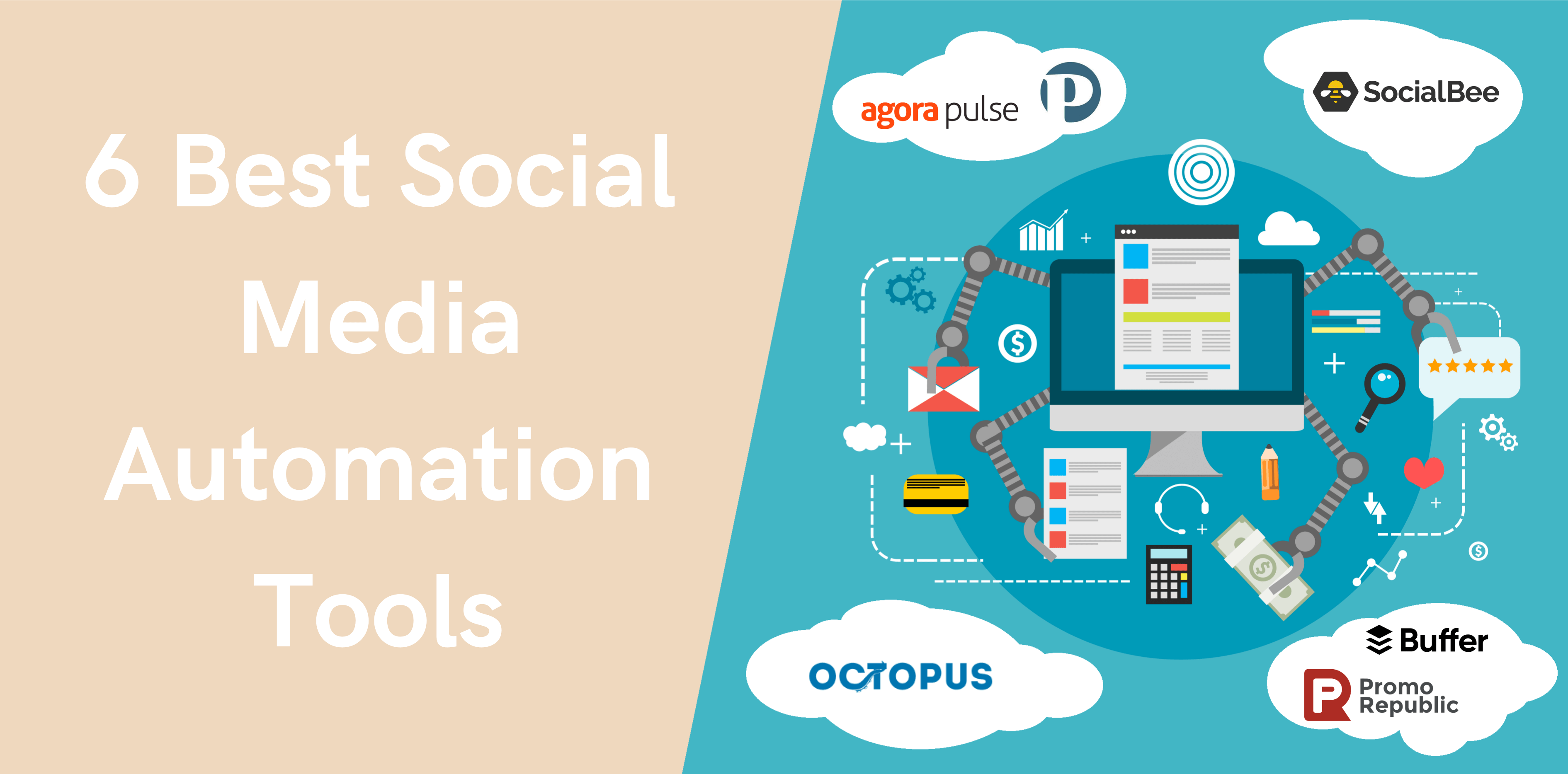Social media automation tools streamline online tasks. They save time and boost efficiency.
In today’s fast-paced digital world, managing social media can be overwhelming. Posting consistently, engaging with followers, and tracking performance require significant effort. Social media automation tools come to the rescue. They help schedule posts, automate responses, and analyze results, making your social media strategy more manageable.
These tools ensure you stay active online without constant manual updates. They also allow you to focus on creating quality content and building genuine connections. By using automation tools, you can maintain a strong online presence while saving time and energy. Let’s explore how these tools can simplify your social media management.
Introduction To Social Media Automation
Social media automation tools have become essential for modern digital marketing. These tools help businesses save time and maintain a consistent online presence. They automate repetitive tasks, allowing marketers to focus on strategy and creativity.
Importance Of Automation
Automation streamlines social media management. It schedules posts in advance, ensuring timely updates. This consistency helps build a strong brand image. Automated tools also track engagement. They provide insights into what content works best.
Using automation, businesses can respond to followers quickly. This improves customer service. Automation reduces the risk of human error. It ensures posts go out as planned, without missing deadlines.
Current Trends
Several trends are shaping social media automation. AI-powered tools are becoming popular. They analyze data to suggest the best times to post. AI can also create content based on user behavior.
Another trend is the integration of automation with other marketing tools. This creates a seamless workflow. Marketers can manage social media, email campaigns, and ads from one platform.
Chatbots are also on the rise. They handle customer inquiries on social media, providing instant support. This enhances the user experience and boosts engagement.
In summary, social media automation tools are evolving. They offer new features that help businesses stay ahead in a competitive market.
Top Social Media Automation Tools
Managing social media can be time-consuming. Social media automation tools can help. These tools schedule posts, monitor engagement, and track performance. Let’s explore some of the top tools available today.
Popular Tools Overview
Several social media automation tools are popular among users. Here’s a list of some noteworthy tools:
- Hootsuite: Known for its user-friendly interface and extensive analytics.
- Buffer: Great for scheduling posts and analyzing performance.
- Sprout Social: Offers robust social listening and reporting features.
- Later: Ideal for Instagram scheduling and visual planning.
- CoSchedule: Integrates well with other marketing tools and platforms.
Features To Look For
When selecting a social media automation tool, consider the following features:
| Feature | Description |
|---|---|
| Scheduling | Plan posts in advance to save time. |
| Analytics | Track performance to understand engagement. |
| Social Listening | Monitor conversations about your brand. |
| Integration | Connect with other tools and platforms. |
| Ease of Use | Simple interface for quick learning. |
Choosing the right tool depends on your needs. Consider these features to make an informed decision.
Benefits Of Using Automation Tools
Social media automation tools are powerful resources for businesses and individuals. These tools streamline processes and enhance productivity. They offer several benefits that make managing social media accounts easier and more effective.
Time-saving Benefits
One of the most significant benefits of social media automation tools is the time they save. Scheduling posts in advance means you don’t have to be online all the time. This allows you to maintain a consistent posting schedule effortlessly.
Automation tools handle repetitive tasks. Tasks like posting updates, responding to comments, and sending direct messages. This frees up your time for more important activities, such as strategy planning and content creation.
Take a look at how much time you can save:
| Task | Manual Time | Automated Time |
|---|---|---|
| Scheduling Posts | 2 hours/week | 30 minutes/week |
| Responding to Comments | 1 hour/day | 15 minutes/day |
| Sending Messages | 1 hour/day | 10 minutes/day |
Enhanced Engagement
Automation tools also enhance engagement with your audience. They ensure timely responses to comments and messages. This leads to increased interaction and customer satisfaction.
These tools can track and analyze your audience’s behavior. They provide insights into the best times to post and the type of content that works best. This helps in tailoring your content to meet your audience’s preferences.
Consider the following benefits:
- Improved response time
- Higher engagement rates
- Better audience insights
Here is an example of improved engagement metrics:
| Metric | Before Automation | After Automation |
|---|---|---|
| Response Time | 2 hours | 10 minutes |
| Engagement Rate | 5% | 15% |
| Audience Growth | 50 followers/month | 200 followers/month |
By using social media automation tools, you can significantly boost your online presence.
How To Choose The Right Tool
Choosing the right social media automation tool can greatly impact your business. The right tool will save time, increase efficiency, and improve your social media strategy. Below, we will discuss how to choose the right tool by assessing business needs and comparing features.
Assessing Business Needs
Before picking a tool, understand your business needs. Ask these questions:
- What are your social media goals?
- How many social media accounts do you manage?
- Do you need analytics and reporting features?
- What is your budget for a social media tool?
Answering these questions will help narrow down your options. Goals and budget play a crucial role in this process.
Comparing Features
Once you know your needs, compare the features of different tools. Consider these factors:
| Feature | Importance |
|---|---|
| Scheduling | High |
| Analytics | Medium |
| Integration with Other Apps | Medium |
| User Interface | High |
| Customer Support | High |
Scheduling is essential for planning posts. Analytics provide insights on performance. Integration with other apps can enhance functionality. A user-friendly interface will make the tool easy to use. Customer support ensures you get help when needed.
By assessing business needs and comparing features, you can choose the right social media automation tool for your business.
Setting Up Automation For Social Media
Social media automation tools can save a lot of time. They help in managing posts, scheduling updates, and tracking engagement. Setting up automation is easy and can streamline your social media efforts.
Initial Setup Steps
The first step is choosing the right tool. There are many options available. Look for one that suits your needs. Next, create an account on the chosen platform. Follow the prompts to enter your details.
After creating an account, explore the dashboard. Most tools have user-friendly interfaces. They often provide tutorials or guides. These can help you understand the features better.
Integrating With Existing Platforms
Link your social media accounts to the automation tool. Most platforms support major social networks. This includes Facebook, Twitter, Instagram, and LinkedIn. Follow the instructions to connect your accounts securely.
Once connected, you can start scheduling posts. Use the calendar feature to plan your content. You can set specific times and dates for your posts. This ensures consistent engagement with your audience.
Automation tools also offer analytics. They help track your performance. Use these insights to improve your social media strategy.

Credit: www.youtube.com
Creating Effective Automation Workflows
Social media automation tools save time and increase productivity. Creating effective workflows ensures that your efforts lead to better engagement and reach. These workflows involve various steps, from scheduling posts to automating responses. Below, we’ll explore how to create these workflows effectively.
Scheduling Posts
Scheduling posts is a crucial part of social media automation. It ensures your content reaches the audience at the right time, even when you are not online. Use tools like Buffer or Hootsuite to plan your posts in advance.
Consider the following steps for effective post scheduling:
- Analyze your audience’s active times.
- Create a content calendar.
- Use analytics to refine your posting schedule.
Here is a simple table to help you plan:
| Day | Time | Content Type |
|---|---|---|
| Monday | 10:00 AM | Blog Post |
| Wednesday | 2:00 PM | Infographic |
| Friday | 6:00 PM | Video |
Automating Responses
Automating responses is another essential part of social media automation. It helps in managing interactions with your audience efficiently. Tools like ManyChat or Chatfuel can help create automated responses.
Follow these steps for effective response automation:
- Set up common responses for frequent queries.
- Use personalized greetings.
- Monitor and refine automated responses regularly.
Automated responses can look like this:
{
"greeting": "Hello! How can we assist you today?",
"common_questions": [
{"question": "What are your working hours?", "response": "We are open from 9 AM to 5 PM."},
{"question": "Where are you located?", "response": "Our office is at 123 Main Street."}
]
}
Automating responses ensures that your audience receives immediate attention, enhancing their experience with your brand.
Measuring Success With Automation
Social media automation tools can save time and effort. Yet, measuring success is key. Understanding how well your strategies work is crucial. This helps in making informed decisions and improving outcomes.
Tracking Key Metrics
To measure success, start with tracking key metrics. Pay attention to engagement rates, follower growth, and click-through rates. These metrics give insights into audience interaction. They show what content resonates most with your followers.
Use analytics tools provided by social platforms. They offer detailed reports on your posts’ performance. Evaluate metrics regularly to stay updated on progress. Consistent tracking helps in identifying trends and patterns over time.
Adjusting Strategies
Automation tools help in adjusting strategies based on data. If a post performs well, create similar content. If engagement drops, try a different approach. Flexibility is essential in social media marketing.
Experiment with posting times and content formats. Use A/B testing to find the best options. Adjusting strategies ensures your efforts align with audience preferences. This leads to better results and more effective campaigns.

Credit: octopuscrm.io
Challenges And Solutions
Social media automation tools offer immense benefits, yet they come with challenges. Businesses often face pitfalls when using these tools. But, with the right solutions, they can overcome these hurdles and make the most of automation.
Common Pitfalls
Many businesses fall into common traps. One issue is over-automation. This leads to robotic and impersonal interactions. Followers notice and engagement drops.
Another problem is poor scheduling. Posting at the wrong times reduces visibility. Messages get lost in the feed, affecting reach and engagement.
Lastly, neglecting analytics is a big mistake. Without monitoring performance, businesses can’t improve their strategies. They miss opportunities for growth and optimization.
Best Practices
To avoid these pitfalls, follow best practices. Balance automation with personal interaction. Use automation for repetitive tasks but engage directly with followers.
Schedule posts at optimal times. Research when your audience is most active. Use data to determine the best posting schedule.
Regularly review analytics. Track performance metrics to understand what works. Adjust strategies based on data insights for better results.
By addressing these challenges and implementing these solutions, businesses can effectively use social media automation tools. They can improve engagement and grow their online presence.
Future Of Social Media Automation
The future of social media automation promises to change the way we interact online. Social media tools will evolve, becoming smarter and more efficient. This transformation will impact businesses, marketers, and users alike.
Emerging Technologies
New technologies are at the core of social media automation’s future. Artificial Intelligence (AI) and Machine Learning (ML) are becoming more advanced. They help in understanding user behavior and preferences. These technologies will create more personalized content and enhance user engagement.
Another key technology is chatbots. AI-driven chatbots can handle customer queries with ease. They provide instant responses, improving user experience. More businesses will adopt chatbots for better customer service.
Blockchain technology is also making its way into social media. It offers transparency and security. This will help in building trust among users. Blockchain can also prevent data breaches and ensure user privacy.
Predicted Trends
Several trends will shape the future of social media automation. Automated content creation is one such trend. AI tools can create engaging posts and articles. This will save time and effort for marketers.
Another trend is predictive analytics. These tools analyze data to predict user behavior. Marketers can use this information to create targeted campaigns. This will improve the effectiveness of social media marketing.
Voice search is also gaining popularity. Social media platforms will need to adapt to this trend. Optimizing content for voice search will become important. This will help in reaching a wider audience.
Finally, video content will dominate social media. Automated video creation tools will become more popular. These tools can create high-quality videos in minutes. This will help businesses engage their audience more effectively.
Credit: www.socialpilot.co
Frequently Asked Questions
What Are Social Media Automation Tools?
Social media automation tools help manage and schedule posts across platforms. They save time by automating repetitive tasks.
How Do Automation Tools Benefit Businesses?
Automation tools enhance efficiency and consistency. They allow businesses to maintain a constant online presence.
Can Automation Tools Improve Engagement?
Yes, automation tools can improve engagement by posting at optimal times. They also help track and analyze performance.
Are Social Media Automation Tools Cost-effective?
Many automation tools offer affordable plans. They provide a good return on investment by saving time and increasing productivity.
Conclusion
Social media automation tools save time and boost productivity. They streamline tasks efficiently. Users can schedule posts, track performance, and engage audiences easily. These tools are essential for consistent online presence. Businesses benefit from improved audience interaction. In a fast-paced world, automation offers a competitive edge.
Choose the right tool to fit your needs. Start simplifying your social media management today. Embrace automation for better results and less stress.

I am a passionate digital marketer with a strong expertise in SEO and article writing. With years of experience in crafting compelling content and optimizing it for search engines, I help businesses enhance their online visibility and drive organic traffic. Whether it’s creating engaging blog posts or implementing effective SEO strategies, I am dedicated to delivering results that make an impact.
